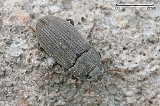
Tenebrioninae
Encyclopedia
Tenebrioninae are a large subfamily of the darkling beetle
s (Tenebrionidae), containing among others the flour beetle
s.
Many of these robust and usually mid-sized beetle
s have elytra with some sort of corrugation on the upperside. They are usually colored blackish, dark brown or grey, and often have a satin
y sheen; they are generally not glossy (some are outright matte) and few are metallic. The body is shaped like a medical capsule or like a bullet
; the legs can be shortish and stout or long and spindly. They eat both fresh and decaying vegetation as well as vegetable produce, and several are commercially important pests e.g. of flour
and other cereal
products.
Tenebrioninae are eaten by large invertebrate
s and small vertebrate
s, such as bird
s, rodent
s, and lizard
s. The larva
l stages of several species
are cultured as feeder insects for captive insectivore
s, and include mealworms and mini mealworms.
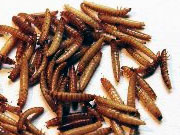 The Mealworm Beetle (Tenebrio molitor) is commonly used as food for terrestrial amniote
The Mealworm Beetle (Tenebrio molitor) is commonly used as food for terrestrial amniote
s kept in terraria. Other Tenebrio and Tribolium species are also bred as animal food. The Red Flour Beetle
(Tribolium castaneum) is a popular genetics
laboratory animal and model organism
, especially in studies of intragenomic conflict
and population ecology
. Several species of Tenebrio and Tribolium (e.g. Confused Flour Beetle
T. confusum, or T. destructor) and other genera (e.g. Gnathocerus cornutus) are pests of cereal
and flour
silo
s and other storage facilities.

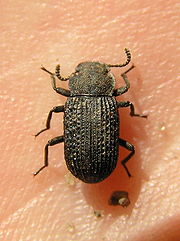
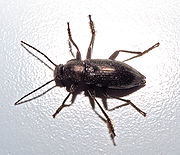
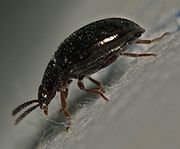
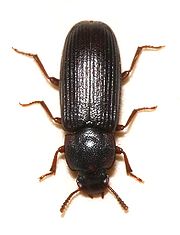
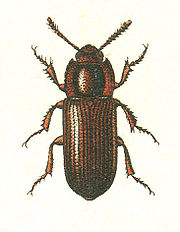 The Tenebrioninae are traditionally divided in some 20-30 tribe
The Tenebrioninae are traditionally divided in some 20-30 tribe
s. The exact delimitation and validity of several of these is disputed however. Molecular phylogenetic studies have yielded highly inconsistent results, perhaps due to any or all of hybridization, horizontal gene transfer
by Wolbachia
bacteria and insufficient taxon
sampling obfuscating
the information contained in DNA sequence
data.
In some treatments, the Pimeliinae are included as yet another tribe. This may be correct, but as far as can be told they are a closely related but well distinct lineage of Tenebrionidae; conversely, the Opatrini
are sometimes elevated to familial rank as Opatrinae. The Crypticini, Pentaphyllini and Scaphidemini are sometimes placed here, but are more commonly located in the Diaperinae.
The tribes (and some notable genera) are:
Acropteronini (disputed)
Alphitobiini Reitter, 1917 (sometimes in Triboliini)
Amarygmini
Apocryphini (disputed)
Blaptini Leach, 1815
Bolitophagini Kirby, 1837
Centronopini (disputed)
Cerenopini (disputed)
Darkling beetle
Darkling beetles are a family of beetles found worldwide, estimated at more than 20,000 species. Many of the beetles have black elytra, leading to their common name...
s (Tenebrionidae), containing among others the flour beetle
Flour beetle
Flour beetles are members of the darkling beetle genus Tribolium or Tenebrio. They are pests of cereal silos and are widely used as laboratory animals, as they are easy to keep. The flour beetles enjoy wheat and other grains and are adapted to survive in very dry environments and can withstand high...
s.
Many of these robust and usually mid-sized beetle
Beetle
Coleoptera is an order of insects commonly called beetles. The word "coleoptera" is from the Greek , koleos, "sheath"; and , pteron, "wing", thus "sheathed wing". Coleoptera contains more species than any other order, constituting almost 25% of all known life-forms...
s have elytra with some sort of corrugation on the upperside. They are usually colored blackish, dark brown or grey, and often have a satin
Satin
Satin is a weave that typically has a glossy surface and a dull back. It is a warp-dominated weaving technique that forms a minimum number of interlacings in a fabric. If a fabric is formed with a satin weave using filament fibres such as silk, nylon, or polyester, the corresponding fabric is...
y sheen; they are generally not glossy (some are outright matte) and few are metallic. The body is shaped like a medical capsule or like a bullet
Bullet
A bullet is a projectile propelled by a firearm, sling, or air gun. Bullets do not normally contain explosives, but damage the intended target by impact and penetration...
; the legs can be shortish and stout or long and spindly. They eat both fresh and decaying vegetation as well as vegetable produce, and several are commercially important pests e.g. of flour
Flour
Flour is a powder which is made by grinding cereal grains, other seeds or roots . It is the main ingredient of bread, which is a staple food for many cultures, making the availability of adequate supplies of flour a major economic and political issue at various times throughout history...
and other cereal
Cereal
Cereals are grasses cultivated for the edible components of their grain , composed of the endosperm, germ, and bran...
products.
Tenebrioninae are eaten by large invertebrate
Invertebrate
An invertebrate is an animal without a backbone. The group includes 97% of all animal species – all animals except those in the chordate subphylum Vertebrata .Invertebrates form a paraphyletic group...
s and small vertebrate
Vertebrate
Vertebrates are animals that are members of the subphylum Vertebrata . Vertebrates are the largest group of chordates, with currently about 58,000 species described. Vertebrates include the jawless fishes, bony fishes, sharks and rays, amphibians, reptiles, mammals, and birds...
s, such as bird
Bird
Birds are feathered, winged, bipedal, endothermic , egg-laying, vertebrate animals. Around 10,000 living species and 188 families makes them the most speciose class of tetrapod vertebrates. They inhabit ecosystems across the globe, from the Arctic to the Antarctic. Extant birds range in size from...
s, rodent
Rodent
Rodentia is an order of mammals also known as rodents, characterised by two continuously growing incisors in the upper and lower jaws which must be kept short by gnawing....
s, and lizard
Lizard
Lizards are a widespread group of squamate reptiles, with nearly 3800 species, ranging across all continents except Antarctica as well as most oceanic island chains...
s. The larva
Larva
A larva is a distinct juvenile form many animals undergo before metamorphosis into adults. Animals with indirect development such as insects, amphibians, or cnidarians typically have a larval phase of their life cycle...
l stages of several species
Species
In biology, a species is one of the basic units of biological classification and a taxonomic rank. A species is often defined as a group of organisms capable of interbreeding and producing fertile offspring. While in many cases this definition is adequate, more precise or differing measures are...
are cultured as feeder insects for captive insectivore
Insectivore
An insectivore is a type of carnivore with a diet that consists chiefly of insects and similar small creatures. An alternate term is entomophage, which also refers to the human practice of eating insects....
s, and include mealworms and mini mealworms.
Notable species

Amniote
The amniotes are a group of tetrapods that have a terrestrially adapted egg. They include synapsids and sauropsids , as well as their fossil ancestors. Amniote embryos, whether laid as eggs or carried by the female, are protected and aided by several extensive membranes...
s kept in terraria. Other Tenebrio and Tribolium species are also bred as animal food. The Red Flour Beetle
Red flour beetle
The red flour beetle is a tenebrionid beetle. It is a worldwide stored product pest.Red flour beetles attack stored grain products causing loss and damage...
(Tribolium castaneum) is a popular genetics
Genetics
Genetics , a discipline of biology, is the science of genes, heredity, and variation in living organisms....
laboratory animal and model organism
Model organism
A model organism is a non-human species that is extensively studied to understand particular biological phenomena, with the expectation that discoveries made in the organism model will provide insight into the workings of other organisms. Model organisms are in vivo models and are widely used to...
, especially in studies of intragenomic conflict
Intragenomic conflict
The selfish gene theory postulates that natural selection will increase the frequency of those genes whose phenotypic effects ensure their successful replication...
and population ecology
Population ecology
Population ecology is a sub-field of ecology that deals with the dynamics of species populations and how these populations interact with the environment. It is the study of how the population sizes of species living together in groups change over time and space....
. Several species of Tenebrio and Tribolium (e.g. Confused Flour Beetle
Confused flour beetle
The confused flour beetle , a type of darkling beetle known as a flour beetle, is a common pest insect known for attacking and infesting stored flour and grain...
T. confusum, or T. destructor) and other genera (e.g. Gnathocerus cornutus) are pests of cereal
Cereal
Cereals are grasses cultivated for the edible components of their grain , composed of the endosperm, germ, and bran...
and flour
Flour
Flour is a powder which is made by grinding cereal grains, other seeds or roots . It is the main ingredient of bread, which is a staple food for many cultures, making the availability of adequate supplies of flour a major economic and political issue at various times throughout history...
silo
Storage silo
A silo is a structure for storing bulk materials. Silos are used in agriculture to store grain or fermented feed known as silage. Silos are more commonly used for bulk storage of grain, coal, cement, carbon black, woodchips, food products and sawdust. Three types of silos are in widespread use...
s and other storage facilities.
Systematics






Tribe (biology)
In biology, a tribe is a taxonomic rank between family and genus. It is sometimes subdivided into subtribes.Some examples include the tribes: Canini, Acalypheae, Hominini, Bombini, and Antidesmeae.-See also:* Biological classification* Rank...
s. The exact delimitation and validity of several of these is disputed however. Molecular phylogenetic studies have yielded highly inconsistent results, perhaps due to any or all of hybridization, horizontal gene transfer
Horizontal gene transfer
Horizontal gene transfer , also lateral gene transfer , is any process in which an organism incorporates genetic material from another organism without being the offspring of that organism...
by Wolbachia
Wolbachia
Wolbachia is a genus of bacteria which infects arthropod species, including a high proportion of insects , as well as some nematodes. It is one of the world's most common parasitic microbes and is possibly the most common reproductive parasite in the biosphere...
bacteria and insufficient taxon
Taxon
|thumb|270px|[[African elephants]] form a widely-accepted taxon, the [[genus]] LoxodontaA taxon is a group of organisms, which a taxonomist adjudges to be a unit. Usually a taxon is given a name and a rank, although neither is a requirement...
sampling obfuscating
Obfuscation
Obfuscation is the hiding of intended meaning in communication, making communication confusing, wilfully ambiguous, and harder to interpret.- Background :Obfuscation may be used for many purposes...
the information contained in DNA sequence
DNA sequence
The sequence or primary structure of a nucleic acid is the composition of atoms that make up the nucleic acid and the chemical bonds that bond those atoms. Because nucleic acids, such as DNA and RNA, are unbranched polymers, this specification is equivalent to specifying the sequence of...
data.
In some treatments, the Pimeliinae are included as yet another tribe. This may be correct, but as far as can be told they are a closely related but well distinct lineage of Tenebrionidae; conversely, the Opatrini
Opatrini
Opatrini is a tribe of darkling beetles in the subfamily Tenebrioninae.-Selected genera:* Adavius* Ammobius* Anemia* Clitobius* Dilamus* Falsocaedius* Gonocephalum* Hadrodes* Hadrus...
are sometimes elevated to familial rank as Opatrinae. The Crypticini, Pentaphyllini and Scaphidemini are sometimes placed here, but are more commonly located in the Diaperinae.
The tribes (and some notable genera) are:
Acropteronini (disputed)
Alphitobiini Reitter, 1917 (sometimes in Triboliini)
- Alphitobius Stephens, 1829
- Diaclina Jacquelin du Val 1861
Amarygmini
- Amarygmus
- Plesiophthalmus
Apocryphini (disputed)
Blaptini Leach, 1815
- Blaps Fabricius, 1775
- Gnaptor Brullé 1832
- Gnaptorina Reitter, 1887
- Prosodes Eschscholtz 1829
- Tagona Fischer von Waldheim 1822
Bolitophagini Kirby, 1837
- Atasthalomorpha
- Bolitoxenus
- Bolitophagus Illiger 1798
- Byrsax
- Eledona Latreille 1796
- Eledonoprius Reitter 19116
Centronopini (disputed)
Cerenopini (disputed)
Dendarini Espanol, 1945 (sometimes in Pedinini)
- Bioplanes Mulsant 1854
- Dendarus Latreille 1829
- Heliopathes Mulsant 1854
- Isocerus Latreille 1829
- Micrositus Mulsant & Rey 1854
- Phylan Dejean, 1821
Dissonomini (disputed)
Eulabini (disputed)
Heleini
Helopini Latreille, 1802
- Allardius
- Catomus
- Cylindronotus Faldermann, 1837
- Enoplopus
- Entomogonus
- Erionura
- Euboeus
- Gunarus
- Hedyphanes
- Helopelius
- Helops
- Italohelops
- Misolampus
- Nalassus Mulsant, 1854
- Nephodinus
- Nesotes
- Odocnemis
- Probaticus
- Pseudoprobaticus
- Raiboscelis
- Stenohelops
- Stenomax Allard, 1876
- Xanthomus
Helopinini (disputed)
Heterotarsini LeConte, 1862 (disputed)
- Heterotarsus
Leichenini Leng, 1920 (disputed)
- Leichenum
Melanimini
Opatrini
Opatrini
Opatrini is a tribe of darkling beetles in the subfamily Tenebrioninae.-Selected genera:* Adavius* Ammobius* Anemia* Clitobius* Dilamus* Falsocaedius* Gonocephalum* Hadrodes* Hadrus...
Brullé, 1832
Palorini Matthews, 2003
- Astalbus
- Austropalorus
- Eutermicola
- Palorinus
- Palorus
- Platycotylus
- Prolabrus
- Pseudeba
- Ulomotypus
Pedinini Eschscholtz, 1829
- Pedinus Latreille, 1796
Platyscelidini Lacordaire, 1859
- Bioramix
- Oodescelis Motschulsky, 1845
Praeugenini (disputed)
Rhyssopausini (disputed)
Scaurini (disputed)
Scotobiini (disputed)
Tenebrionini Latreille, 1802 (including Biuini)
- Bius Dejean, 1834
- Cryphaeus Klug 1833
- Encyalesthus
- Iphthiminus Spilman 1973
- Menephilus Mulsant 1854
- Neatus Le Conte, 1862
- Tenebrio Linnaeus, 1758
- Upis
Titaenini
- Artystona
- Callismilax
- Cerodolus
- Demtrius
- Leaus
- Partystona
- Pseudhelops
- Titaena
Toxicini Lacordaire, 1859
Triboliini Mulsant, 1854 (sometimes in Ulomini)
- Aesymnus
- Erelus Mulsant & Rey 1853 (tentatively placed here)
- Latheticus Waterhouse, 1880
- Lyphia
- Martianus Fairmaire, 1893 (tentatively placed here)
- Metulosonia
- Mycotrogus
- Palorus Mulsant, 1854
- Tharsus
- Tribolium Macleay, 1825 (probably paraphyletic)
- Ulosonia
Ulomini Blanchard, 1845
- Gnathocerus
- Pelleas Bates 1872
- Uloma Dejean, 1821
- Ulomina Baudi 1876 (sometimes in Palorini)
In addition, the genus Aphtora is of uncertain placement in this subfamily.

